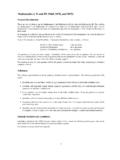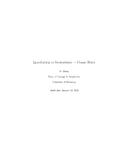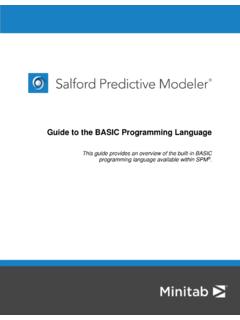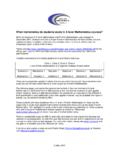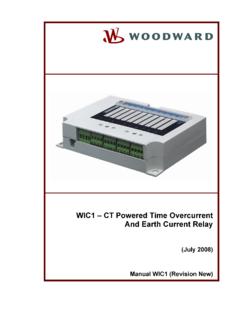Transcription of Random Variables and Measurable Functions.
1 Chapter 3 Random Variables andMeasurable MeasurabilityDefinition 42( Measurable function) Letfbe a function from a measurablespace( ,F)into the real numbers. We say that the function ismeasurableiffor each Borel setB B,theset{ ;f( ) B} 43( Random variable ) Arandom variableXis a Measurable func-tion from a probability space( ,F,P)into the real numbers<.Definition 44(Indicator Random Variables ) For an arbitrary setA FdefineIA( )=1if Aand0otherwise. Thisiscalledanindicator 45(Simple Random Variables ) Consider eventsAi F,i=1,2,3, .., nsuch that ni=1Ai= .DefineX( )=Pni=1ciIAi( )whereci <. ThenXis Measurable and is consequently a Random variable . We normally assumethat the setsAiare disjoint. Because this is a Random variable which cantake onlyfinitely many different values, then it is calledsimpleand any randomvariable taking onlyfinitely many possible values can be written in this 46(binomial tree) A stock, presently worth $20, can increase eachday by $1 or decrease by $1.
2 We observe the process for a total of 5 days. DefineXto be the value of the stock at the end offive days. Describe( ,F)andthe functionX( ).Define another Random variableYto be the value of thestock after 4 1(B)={ ;X( ) B}. We will also sometimes denote this event[X B].Intheaboveexample,define the eventsX 1(B)andY 1(B)whereB=[20, ).1314 CHAPTER 3. Random Variables AND Measurable we have the any Borel setsBn <, and any Random variableX, 1( nBn)= nX 1(Bn) 1( nBn)= nX 1(Bn)3.[X 1(B)]c=X 1(Bc)These three properties together imply that for any class of setsC,X 1( (C)) = (X 1(C)).SoXis Measurable if, for allx,{ ;X( ) x} F(see Theorem16 and Problem ).BEWARE:ThefactthatweusenotationX 1does not imply that thefunctionXhas an inverse in the usual sense.]
3 For example, ifX( )=sin( )for <,thenwhatisX 1([.5,1])?Theorem 47(combining Random Variables ) SupposeXi,i=1,2,..are all( Measurable ) Random Variables . Then so +X2+X3+.. anyc {Xn;n 1}6. lim {Xn;n 1} supn 1. notice that [X1+X2>x]if and only if there is a rationalnumberqin the intervalX1>q>x X2so that[X1>q]and[X2>x q].In other words[X1+X2>x]= q[X1>q] [X2>x q]where the union is over all rational 2, note that forx 0,[X21 x]=[X1 0] [X1 x] [X1<0] [X1 x].For 3, in the casec>0,notice that[cX1 x]=[X1 xc].Finally 4 follows from properties 1, 2 and 3 sinceX1X2=12{(X1+X2)2 X21 X22} MEASURABILITY15 For 5. note that[infXn x]= n=1[Xn x].For 6. note that [lim infXn x]=[Xn>x 1 ] for allm=1,2, ..so[lim infXn x]= m=1lim inf[Xn>x 1/m].
4 The remaining two properties follow by replacingXnby 48(sigma-algebra generated by Random Variables ) ForXarandomvariable, define (X)={X 1(B);B B}. (X)is the smallest sigma algebraFsuch thatXis a Measurable functioninto<. The fact that it is a sigma-algebra follows from Theorem 16. Similarly,for a set of Random variablesX1,X2,..Xn,thesigmaalgebra (X1,..Xn)generated by these is the smallest sigma algebra such that allXiare 49 (X)is a sigma-algebra and is the same as {[X x],x <}.Definition 50 ABorel Measurable functionffrom< <is a function suchthatf 1(B) Bfor allB example if a functionf(x)is a continuous function from a subset of<into a subset of<then it is Borel 51 Supposefi,i=1,2,..are all Borel Measurable so +f2+f3+.
5 Any real {fn;n 1} {fn;n 1} fnTheorem 52 IfXandYare both Random Variables , thenYcan be written asa Borel Measurable function ofX, (X)for some Borel measurablefif and only if (Y) (X)16 CHAPTER 3. Random Variables AND Measurable (X).Then for an arbitrary Borel setB,[Y B]=[f(X) B]=[X f 1(B)] = [X B2]for Borel setB2 shows that (Y) (X).For the converse, we assume that (Y) (X)andwewishtofind aBorel Measurable functionfsuch thatY=f(X).Forfixednconsider the setAm,n={ ;m2 n Y( )<(m+1)2 n}form=0, 1, .. Since this set isin (Y)it is also in (X)and therefore can be written as{ ;X( ) Bm,n}for some Borel subsetBm,nof the real line. Consider the functionfn(x)=Pmm2 nI(x Bm,n).Clearly this function is defined so thatfn(X)is closetoY,andindeediswithin12nunits function we seek is obtained bytaking the limitf(x)= limn fn(x).
6 We require two results,first that the limit exists and second that the limitsatisfies the propertyf(X)= of the sequence follows from thefact that for eachx,the sequencefn(x)is monotonically increasing (this isProblem 22). The fact thatY=f(X)follows easily since for eachn, fn(X) Y fn(X)+ limits asn givesf(X) Y f(X).Example 53 Consider =[0,1]with Lebesgue measure and define a ran-dom variableX( )=a1,a2,a3(any three distinct real numbers) for [0,1/4],(1/4,1/2],(1/2,1]respectively. Find (X).Now consider a randomvariableYsuch thatY( )=0or1as [0,1/2],(1/2,1]respectively. Verifythat (Y) (X)and that we can writeY=f(X)for some Borel measurablefunctionf(.). cumulative distribution FunctionsDefinition 54 Thecumulative distribution function( ) of arandom vari-ableXis defined to be the functionF(x)=P[X x],forx <.)))
7 Similarly, if is a measure on<, then the cumulative distribution function is definedtobeF(x)= ( ,x]. Note in the latter case, the function may take the value .Theorem 55( Properties of the cumulative distribution Function)1. A (x)is non-decreasing. (y) F(x)whenevery (x) 0,asx .3. WhenF(x)is the of a Random variable ,F(x) 1,asx . (x)is right continuous. (x)=limF(x+h)ashdecreases Ifx ythenX ximpliesX yor in set theoretic terms[X x] [X y].ThereforeP(X x) P(X y). cumulative distribution FUNCTIONS172. IfXis a real-valued Random variable then[X= ]= the empty for any sequencexndecreasingto ,limF(xn) = limP(X xn)=P( n=1[X xn])(since the sequence is nested)=P( )=03. Again ifXis a real-valued Random variable then[X< ]= and forany sequencexnincreasingto ,limF(xn) = limP(X xn)=P( n=1[X xn])(since the sequence is nested)=P( )= For any sequencehndecreasing to0,limF(x+hn) = limP(X x+hn)=P( n=1[X x+hn])(since the sequence is nested)=P(X x)=F(x)Theorem 56(existence of limits) Any bounded non-decreasing function has atmost countably many discontinuities and possesses limits from both the rightand the left.)
8 In particular this holds for cumulative distribution (x)from the left byF(x )=limhF(x h)ashdecreases to 0. ThenP[X<x]=F(x )andP[X=x]=F(x) F(x ), 57 Letxibe any sequence of real numbers andpiasequenceofnon-negative numbers such thatPipi= (x)=X{i;xi x}pi.( )This is the of a distribution which takes each valuexiwith is one with for which there is a countable setSwithP[X S]=1. Any discrete distribution has cumulative distribution functionof the form ( ).Theorem 58 IfF(x)satisfies properties 1-4 of Theorem 19, then there exists aprobability space( ,F,P)and a Random variableXdefined on this probabilityspace such thatFis the 3. Random Variables AND Measurable define the probability space to be =(0,1)withFtheBorel sigma algebra of subsets of the unit interval andPthe Borel ( )=sup{z;F(z)< }.
9 Notice that for anyc,X( )>cimplies >F(c). On the other hand if >F(c)then sinceFis right continuous,for some >0, >F(c+ )andthisinturnimpliesthatX( ) c+ > follows thatX( )>cif and only if >F(c). ThereforeP[X( )>c]=P[ >F(c)] = 1 F(c)and soFis the cumulative distribution function Problems1. If =[0,1]andPis Lebesgue measure,findX 1(C)whereC=[0,12)andX( )= Define ={1,2,3,4}and the sigma algebraF={ , ,{1},{2,3,4}}.Describe all Random Variables that are Measurable on the probability space( ,F).3. Let ={ 2, 1,0,1,2}and consider a Random variable defined byX( )= (X),the sigma algebra generated ifX( )=| |or ifX( )= + Find two different Random Variables defined on the space =[0,1]withLebesgue measure which have exactly the same distribution .]
10 Can youarrange that these two Random Variables are independent of one another?5. IfXi;i=1,2, ..are Random Variables , prove thatmaxi nXiis arandom Variables and thatlimsup1nPiXiis a Random IfXi;i=1,2,..are Random Variables , prove arandom Let denote the set of all outcomes when tossing an unbiased coin threetimes. Describe the probability space and the Random variableX=the number of heads observed. Find the cumulative distribution functionP[X x].8. A numberxis called a point of increase of a distribution functionFifF(x+ ) F(x )>0for all >0. Construct a discrete distribu-tion function such that every real number is a point of increase. (Hint:Can you define a discrete distribution supported on the set of all rationalnumbers?)


